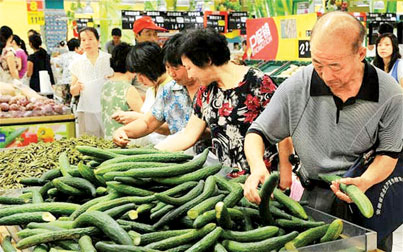China Oct inflation seen cooler, not enough to trim rates
BEIJING - China's annual inflation rate likely cooled to 5.5 percent
in October, data is expected to show on Wednesday, a third straight
month of decline from July's three-year peak though still insufficient
for monetary policy to be materially eased.
"We expect (an) unchanged macro policy stance for now," economists at
UBS said in a client note ahead of the numbers due for release at 0130
GMT, which kick off a deluge of price, investment, money supply and
trade data this week.
UBS expects falling food prices - particularly pork - to have capped
consumer price inflation (CPI) at 5.3 percent year on year in October,
after a 6.1 percent reading in September and 6.5 percent in July.
 That is at the bottom of the range of forecasts from the 21
economists quoted in the benchmark Reuters poll, where the consensus
view is for year-on-year rise of 5.5 percent. That is at the bottom of the range of forecasts from the 21
economists quoted in the benchmark Reuters poll, where the consensus
view is for year-on-year rise of 5.5 percent.
Deutsche Bank and Bank of Communications International also have a
5.3 percent call for October, while China Construction Bank and
Shanghai-based private investment advisory firm CEBM top the range of
forecasts at 5.8 percent.
Inflation remains the key focus for investors, with cooling price
pressures fuelling expectations that the central bank may start to ease
monetary policy as exporters feel the chill from slowing global growth.
China's leaders have begun talking in recent weeks about "fine
tuning" macro economic policy to maintain economic growth, while making
it clear that stabilising prices and fighting inflation remain the top
priority.
Most evidence of that so far has been seen through tweaks to tax
policy aimed at small and medium-sized businesses and some signs that
bank lending to that sector of the economy - which supports 75 percent
of China's jobs - could be relaxed.
"More visible fiscal and credit easing are expected in Q1 2012, after
exports and construction have led to much slower industrial production
growth," UBS said.
Analysts at ANZ, however, believe the economic data is deteriorating
so quickly that the People's Bank of China (PBOC) could soon start to
ease policy by reversing some of the nine hikes to bank reserve
requirement ratios (RRR) made in the tightening cycle that began in
October 2010.
China's big manufacturers ran at their slowest pace in October since
early 2009, the latest private sector survey of purchasing managers
showed, though there were signs of smaller firms bouncing back and a
sharp fall in factory-gate prices.
Producer price inflation is forecast to have eased to 5.7 percent in
October from year ago levels versus 6.5 percent in September, with
slowing industrial output seen heralding a further deceleration in the
world's second-largest economy.
"We revise our 'selective' policy easing call to an 'outright' policy
easing, meaning that in an imminent move, the PBOC will likely make a 50
basis point cut to the RRR for all banks, with a possible larger cut of
100 bps for small and medium-sized banks," ANZ said in a note to clients
last week.
The bank cites signs of softness in the real estate market as being
particularly important, given that Chinese banks tend to prefer land and
property as loan collateral.
Some interpretation of conditions in the real estate market could be
made by 0530 GMT when fixed asset investment (FAI) data are released.
Real estate makes up about 20 percent of China's FAI, a primary driver
of overall economic growth.
FAI growth is expected to have eased marginally to 24.7 percent in
October from 24.9 percent in September and continuing a broad two-year
trend of gradual cooling .
Reuters
|

